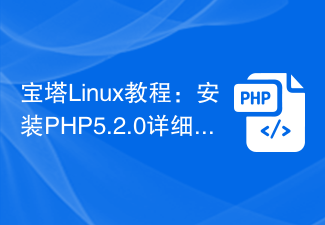 Topics
Topics Pagoda Panel
Pagoda Panel Teach you to use Pagoda to quickly deploy front-end projects (pictures and texts)
Teach you to use Pagoda to quickly deploy front-end projects (pictures and texts)This article is provided by the tutorial column of Pagoda Panel to introduce how to use Pagoda to quickly deploy front-end projects. I hope it will be helpful to you if you need it!
1. Environment installation
1. Domain name resolution binding The
IPaddress of your own server-
2. Install the pagoda
yumВ installВ -yВ wgetВ &&В wgetВ -OВ install.shВ http://download.bt.cn/install/install_6.0.shВ &&В shВ install.sh
3. Wait for a few minutes. After the installation is completed, The login account and password will appear on the page (copy them first, and you can modify them after logging in)

4. Administer the security group on the Alibaba Cloud server
8888The port is open5. Use the above account and password to log in to your pagoda interface and modify the user name and password [mainly for the convenience of remembering the account and password]

3. Use Pagoda to deploy static projects
1. Install
nginxsoftware
2. Deploy static projects

3. Access directly on the browser (enter yourself Domain name)

4. If you want to create other static projects


- ##5. Enter the
domain name/folder name in the browser
to access the static project just now
PM2DeploymentnodeProject
- 1. Install
pm2
tools in the software store - 2.In
pm2
вҖҷs management interface switchnodeversion - 3. Create a folder in the directory of the site
express_demo
- 4. Install the scaffolding of
express
npmВ installВ express-generator
- 5. Generate the project file in the
express_demo
directoryexpressВ -enpmВ install
- 6. Development port [very important]
- Open the port in the pagoda

- If you are using Alibaba Cloud server, you need to continue to open the port on the server side
- Open the port in the pagoda
- 7. In the panel of
PM2
Addexpress_demoproject startup
- 8. Enter the domain name in the browser or
IP
with port 3000
nginx and reverse proxy to the node project
- 1. Click Website settings

- 2. Modify the configuration file of
nginx
 ##3. To test, directly enter
##3. To test, directly enter - domain name/express
in the browser
The above is the detailed content of Teach you to use Pagoda to quickly deploy front-end projects (pictures and texts). For more information, please follow other related articles on the PHP Chinese website!
 е®қеЎ”йқўжқҝиғҪеҗҰйғЁзҪІGoиҜӯиЁҖйЎ№зӣ®пјҹMar 23, 2024 pm 06:54 PM
е®қеЎ”йқўжқҝиғҪеҗҰйғЁзҪІGoиҜӯиЁҖйЎ№зӣ®пјҹMar 23, 2024 pm 06:54 PMж Үйўҳпјҡе®қеЎ”йқўжқҝеҰӮдҪ•йғЁзҪІGoиҜӯиЁҖйЎ№зӣ®пјҹеңЁеҪ“д»Ҡзҡ„дә’иҒ”зҪ‘ж—¶д»ЈпјҢGoиҜӯиЁҖдҪңдёәдёҖз§Қй«ҳж•ҲгҖҒз®ҖжҙҒгҖҒ并еҸ‘жҖ§иғҪејәеӨ§зҡ„зј–зЁӢиҜӯиЁҖпјҢеҸ—еҲ°дәҶи¶ҠжқҘи¶ҠеӨҡејҖеҸ‘иҖ…зҡ„йқ’зқҗгҖӮиҖҢе®қеЎ”йқўжқҝдҪңдёәдёҖж¬ҫеҠҹиғҪејәеӨ§зҡ„жңҚеҠЎеҷЁз®ЎзҗҶе·Ҙе…·пјҢжҸҗдҫӣдәҶдҫҝжҚ·зҡ„з•Ңйқўж“ҚдҪңе’Ңеҗ„з§ҚиҮӘеҠЁеҢ–йғЁзҪІеҠҹиғҪгҖӮйӮЈд№ҲпјҢе®қеЎ”йқўжқҝжҳҜеҗҰиғҪеӨҹйғЁзҪІGoиҜӯиЁҖйЎ№зӣ®е‘ўпјҹзӯ”жЎҲжҳҜиӮҜе®ҡзҡ„пјҢжҺҘдёӢжқҘе°ҶиҜҰз»Ҷи®Іи§ЈеҰӮдҪ•еңЁе®қеЎ”йқўжқҝдёҠйғЁзҪІGoиҜӯиЁҖйЎ№зӣ®пјҢ并жҸҗдҫӣе…·дҪ“зҡ„д»Јз ҒзӨәдҫӢгҖӮйҰ–е…ҲпјҢжҲ‘们
 еҰӮдҪ•йҖҡиҝҮе®қеЎ”йқўжқҝиҝӣиЎҢзҪ‘з«ҷжҖ§иғҪеҺӢжөӢе’Ңи°ғдјҳJun 21, 2023 pm 01:31 PM
еҰӮдҪ•йҖҡиҝҮе®қеЎ”йқўжқҝиҝӣиЎҢзҪ‘з«ҷжҖ§иғҪеҺӢжөӢе’Ңи°ғдјҳJun 21, 2023 pm 01:31 PMйҡҸзқҖдә’иҒ”зҪ‘зҡ„еҝ«йҖҹеҸ‘еұ•пјҢзҪ‘з«ҷжҖ§иғҪеҜ№дәҺз”ЁжҲ·дҪ“йӘҢе’ҢSEOжҺ’еҗҚзҡ„еҪұе“Қи¶ҠжқҘи¶ҠеӨ§гҖӮдёәдәҶжҸҗй«ҳиҮӘе·ұзҡ„зҪ‘з«ҷжҖ§иғҪпјҢжҲ‘们йңҖиҰҒиҝӣиЎҢжҖ§иғҪеҺӢжөӢе’Ңи°ғдјҳжқҘе®ҡдҪҚй—®йўҳ并иҝӣиЎҢдјҳеҢ–гҖӮиҖҢе®қеЎ”йқўжқҝдҪңдёәдёҖдёӘе№ҝеҸ—ж¬ўиҝҺзҡ„жңҚеҠЎз®ЎзҗҶйқўжқҝпјҢжҸҗдҫӣдәҶж–№дҫҝз®ҖеҚ•зҡ„жҖ§иғҪеҺӢжөӢе’Ңи°ғдјҳе·Ҙе…·гҖӮдёӢйқўе°Ҷд»Ӣз»ҚеҰӮдҪ•йҖҡиҝҮе®қеЎ”йқўжқҝиҝӣиЎҢзҪ‘з«ҷжҖ§иғҪеҺӢжөӢе’Ңи°ғдјҳгҖӮдёҖгҖҒжҖ§иғҪеҺӢжөӢжҖ§иғҪеҺӢжөӢжҳҜйҖҡиҝҮжЁЎжӢҹз”ЁжҲ·и®ҝй—®жқҘжөӢиҜ•зҪ‘з«ҷзҡ„иҙҹиҪҪиғҪеҠӣе’Ңе“Қеә”йҖҹеәҰгҖӮеңЁе®қеЎ”йқўжқҝдёӯпјҢжҲ‘们еҸҜ
 е®қеЎ”PHPзүҲжң¬еҲҮжҚўпјҡиҜҰз»Ҷж“ҚдҪңжӯҘйӘӨи§ЈиҜ»Mar 04, 2024 pm 05:48 PM
е®қеЎ”PHPзүҲжң¬еҲҮжҚўпјҡиҜҰз»Ҷж“ҚдҪңжӯҘйӘӨи§ЈиҜ»Mar 04, 2024 pm 05:48 PMе®қеЎ”PHPзүҲжң¬еҲҮжҚўпјҡиҜҰз»Ҷж“ҚдҪңжӯҘйӘӨи§ЈиҜ»пјҢйңҖиҰҒе…·дҪ“д»Јз ҒзӨәдҫӢйҡҸзқҖдә’иҒ”зҪ‘жҠҖжңҜзҡ„дёҚж–ӯеҸ‘еұ•пјҢзҪ‘з«ҷејҖеҸ‘дёӯеёёеёёдјҡж¶үеҸҠеҲ°дҪҝз”ЁдёҚеҗҢзүҲжң¬зҡ„PHPгҖӮе®қеЎ”йқўжқҝжҳҜдёҖж¬ҫз®ҖеҚ•жҳ“з”Ёзҡ„жңҚеҠЎеҷЁз®ЎзҗҶиҪҜ件пјҢеҸҜд»Ҙеё®еҠ©з”ЁжҲ·еҝ«йҖҹжҗӯе»әе’Ңз®ЎзҗҶжңҚеҠЎеҷЁзҺҜеўғгҖӮеңЁзҪ‘з«ҷејҖеҸ‘иҝҮзЁӢдёӯпјҢжңүж—¶йңҖиҰҒеҲҮжҚўPHPзүҲжң¬д»ҘйҖӮеә”дёҚеҗҢзҡ„йңҖжұӮпјҢжң¬ж–Үе°ҶиҜҰз»Ҷи§ЈиҜ»еҰӮдҪ•еңЁе®қеЎ”йқўжқҝдёӯиҝӣиЎҢPHPзүҲжң¬еҲҮжҚўпјҢ并з»ҷеҮәе…·дҪ“зҡ„ж“ҚдҪңжӯҘйӘӨе’Ңд»Јз ҒзӨәдҫӢгҖӮжӯҘйӘӨдёҖпјҡзҷ»еҪ•е®қеЎ”йқў
 е®қеЎ”Linuxеҝ…иҜ»пјҡPHP5.2.0зүҲжң¬е®үиЈ…жҠҖе·§Mar 07, 2024 pm 12:33 PM
е®қеЎ”Linuxеҝ…иҜ»пјҡPHP5.2.0зүҲжң¬е®үиЈ…жҠҖе·§Mar 07, 2024 pm 12:33 PMе®қеЎ”Linuxеҝ…иҜ»пјҡPHP5.2.0зүҲжң¬е®үиЈ…жҠҖе·§еңЁдҪҝз”Ёе®қеЎ”Linuxйқўжқҝжҗӯе»әзҪ‘з«ҷзҡ„иҝҮзЁӢдёӯпјҢдёҖдәӣж—§зүҲжң¬зҡ„PHPзҺҜеўғеҸҜиғҪдјҡиў«йңҖжұӮжүҖйңҖпјҢжҜ”еҰӮPHP5.2.0зүҲжң¬гҖӮжң¬ж–Үе°Ҷд»Ӣз»ҚеҰӮдҪ•еңЁе®қеЎ”LinuxйқўжқҝдёҠе®үиЈ…PHP5.2.0зүҲжң¬пјҢ并жҸҗдҫӣе…·дҪ“зҡ„д»Јз ҒзӨәдҫӢпјҢеё®еҠ©иҜ»иҖ…еҝ«йҖҹе®ҢжҲҗе®үиЈ…иҝҮзЁӢгҖӮдёҖгҖҒе®үиЈ…PHP5.2.0зүҲжң¬жӯҘйӘӨдёҖпјҡиҝӣе…Ҙе®қеЎ”LinuxйқўжқҝйҰ–е…ҲпјҢеңЁжөҸи§ҲеҷЁдёӯиҫ“е…ҘдҪ зҡ„жңҚеҠЎеҷЁIPең°
 е®қеЎ”е®үиЈ…phpжҖҺд№ҲеҲҮжҚўдҪҝз”Ёеҗ„зүҲжң¬Jun 19, 2023 am 11:18 AM
е®қеЎ”е®үиЈ…phpжҖҺд№ҲеҲҮжҚўдҪҝз”Ёеҗ„зүҲжң¬Jun 19, 2023 am 11:18 AMе®қеЎ”е®үиЈ…phpеҲҮжҚўдҪҝз”Ёеҗ„зүҲжң¬зҡ„ж–№жі•жҳҜпјҡ1гҖҒеңЁе®қеЎ”йқўжқҝйҰ–йЎөзӮ№еҮ»вҖңжҲ‘зҡ„зҪ‘з«ҷвҖқпјӣ2гҖҒжүҫеҲ°еҜ№еә”зҡ„зҪ‘з«ҷпјҢзӮ№еҮ»еҸідҫ§зҡ„вҖңи®ҫзҪ®вҖқжҢүй’®пјӣ3гҖҒзӮ№еҮ»е·Ұдҫ§зҡ„вҖңApache/NginxвҖқйҖүйЎ№еҚЎпјҢеҸҜд»ҘзңӢеҲ°еҪ“еүҚдҪҝз”Ёзҡ„PHPзүҲжң¬пјӣ4гҖҒзӮ№еҮ»PHPзүҲжң¬еҗҺйқўзҡ„вҖңеҲҮжҚўвҖқжҢүй’®пјҢйҖүжӢ©йңҖиҰҒеҲҮжҚўзҡ„зүҲжң¬пјӣ5гҖҒйҮҚж–°еҗҜеҠЁзӣёе…іжңҚеҠЎеҚіеҸҜгҖӮ
 е®қеЎ”Linuxж•ҷзЁӢпјҡе®үиЈ…PHP5.2.0иҜҰз»ҶжӯҘйӘӨMar 06, 2024 pm 02:27 PM
е®қеЎ”Linuxж•ҷзЁӢпјҡе®үиЈ…PHP5.2.0иҜҰз»ҶжӯҘйӘӨMar 06, 2024 pm 02:27 PMеңЁиҝҷзҜҮж–Үз« дёӯпјҢжҲ‘дјҡдёәеӨ§е®¶иҜҰз»Ҷд»Ӣз»ҚеҰӮдҪ•еңЁе®қеЎ”йқўжқҝдёҠе®үиЈ…PHP5.2.0зүҲжң¬зҡ„жӯҘйӘӨпјҢеҢ…жӢ¬е…·дҪ“зҡ„д»Јз ҒзӨәдҫӢгҖӮPHP5.2.0иҷҪ然已з»ҸжҜ”иҫғиҖҒж—§пјҢдҪҶд»Қ然жңүдёҖдәӣзү№ж®ҠйңҖжұӮзҡ„йЎ№зӣ®дјҡйңҖиҰҒдҪҝз”ЁиҝҷдёӘзүҲжң¬гҖӮеёҢжңӣиҝҷзҜҮж•ҷзЁӢеҜ№еӨ§е®¶жңүжүҖеё®еҠ©гҖӮеңЁдҪҝз”Ёе®қеЎ”Linuxйқўжқҝзҡ„иҝҮзЁӢдёӯпјҢжңүж—¶еҖҷжҲ‘们дјҡйҒҮеҲ°йңҖиҰҒе®үиЈ…PHP5.2.0зҡ„жғ…еҶөгҖӮеңЁиҝҷзҜҮж•ҷзЁӢдёӯпјҢжҲ‘е°ҶдёәеӨ§е®¶иҜҰз»Ҷд»Ӣз»ҚеҰӮдҪ•еңЁе®қеЎ”йқўжқҝдёҠе®үиЈ…PHP5.
 дёҖй”®жҗһе®ҡпјҒе®қеЎ”LinuxдёҠе®үиЈ…PHP5.2.0жҢҮеҚ—Mar 06, 2024 pm 04:33 PM
дёҖй”®жҗһе®ҡпјҒе®қеЎ”LinuxдёҠе®үиЈ…PHP5.2.0жҢҮеҚ—Mar 06, 2024 pm 04:33 PMж ҮйўҳпјҡдёҖй”®жҗһе®ҡпјҒе®қеЎ”LinuxдёҠе®үиЈ…PHP5.2.0жҢҮеҚ—еңЁеҪ“еүҚдә’иҒ”зҪ‘ж—¶д»ЈпјҢзҪ‘з«ҷејҖеҸ‘зҰ»дёҚејҖPHPгҖӮPHP5.2.0зүҲжң¬зӣёжҜ”иҫғдәҺзҺ°еңЁзҡ„зүҲжң¬е·Із»ҸиҝҮж—¶дәҶпјҢдҪҶжңүж—¶еҖҷжҲ‘们д»Қ然йңҖиҰҒеңЁе®қеЎ”йқўжқҝдёҠе®үиЈ…PHP5.2.0зүҲжң¬пјҢеҸҜиғҪжҳҜдёәдәҶе…је®№дёҖдәӣж—§зҡ„йЎ№зӣ®жҲ–иҖ…йңҖжұӮгҖӮеңЁиҝҷзҜҮж–Үз« дёӯпјҢжҲ‘们е°Ҷд»Ӣз»ҚеҰӮдҪ•еңЁе®қеЎ”LinuxдёҠдёҖй”®жҗһе®ҡе®үиЈ…PHP5.2.0зҡ„иҝҮзЁӢпјҢеёҢжңӣиғҪеҜ№дҪ жңүжүҖеё®еҠ©гҖӮжӯҘйӘӨдёҖ
 е®қеЎ”дёҖй”®е®үиЈ…PHPпјҢиҪ»жқҫеҲҮжҚўеҗ„зүҲжң¬Mar 04, 2024 pm 03:12 PM
е®қеЎ”дёҖй”®е®үиЈ…PHPпјҢиҪ»жқҫеҲҮжҚўеҗ„зүҲжң¬Mar 04, 2024 pm 03:12 PMе®қеЎ”дёҖй”®е®үиЈ…PHPпјҢиҪ»жқҫеҲҮжҚўеҗ„зүҲжң¬е®қеЎ”жҳҜдёҖж¬ҫзҪ‘з»ңжңҚеҠЎеҷЁз®ЎзҗҶиҪҜ件пјҢжҸҗдҫӣдәҶдёҖй”®е®үиЈ…е’Ңз®ЎзҗҶеҗ„з§ҚжңҚеҠЎеҷЁзҺҜеўғзҡ„еҠҹиғҪпјҢеҢ…жӢ¬PHPгҖҒMySQLгҖҒNginxзӯүгҖӮжң¬ж–Үе°Ҷд»Ӣз»ҚеҰӮдҪ•йҖҡиҝҮе®қеЎ”дёҖй”®е®үиЈ…PHPпјҢ并且演зӨәеҰӮдҪ•иҪ»жқҫеҲҮжҚўеҗ„дёӘPHPзүҲжң¬гҖӮдёҖгҖҒе®үиЈ…е®қеЎ”йқўжқҝйҰ–е…ҲпјҢжҲ‘们йңҖиҰҒеңЁжңҚеҠЎеҷЁдёҠе®үиЈ…е®қеЎ”йқўжқҝгҖӮеҸҜд»ҘйҖҡиҝҮд»ҘдёӢе‘Ҫд»ӨиҝӣиЎҢе®үиЈ…пјҡwget-Oinstall.shhttp://downl


Hot AI Tools

Undresser.AI Undress
AI-powered app for creating realistic nude photos

AI Clothes Remover
Online AI tool for removing clothes from photos.

Undress AI Tool
Undress images for free

Clothoff.io
AI clothes remover

AI Hentai Generator
Generate AI Hentai for free.

Hot Article

Hot Tools

EditPlus Chinese cracked version
Small size, syntax highlighting, does not support code prompt function

SublimeText3 Chinese version
Chinese version, very easy to use

DVWA
Damn Vulnerable Web App (DVWA) is a PHP/MySQL web application that is very vulnerable. Its main goals are to be an aid for security professionals to test their skills and tools in a legal environment, to help web developers better understand the process of securing web applications, and to help teachers/students teach/learn in a classroom environment Web application security. The goal of DVWA is to practice some of the most common web vulnerabilities through a simple and straightforward interface, with varying degrees of difficulty. Please note that this software

PhpStorm Mac version
The latest (2018.2.1) professional PHP integrated development tool

Dreamweaver CS6
Visual web development tools


















